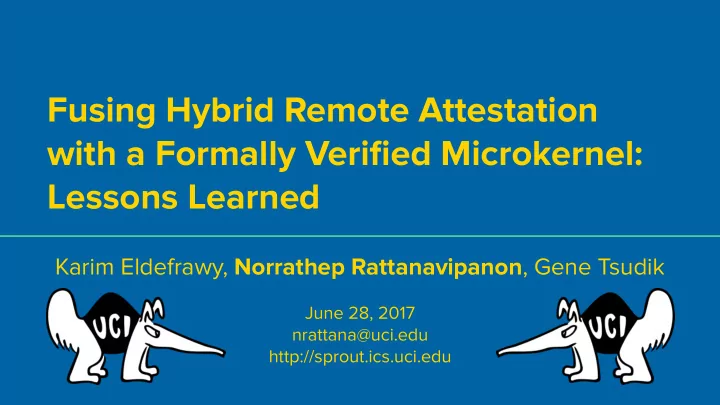

Fusing Hybrid Remote Attestation with a Formally Verified Microkernel: Lessons Learned Karim Eldefrawy, Norrathep Rattanavipanon , Gene Tsudik June 28, 2017 nrattana@uci.edu http://sprout.ics.uci.edu
IoT/CPS/ES
IoT/CPS/ES
IoT/CPS/ES
Remote Attestation (RA) ★ Remote verification of internal state of a prover by a verifier ○ Secure updates, deletion/reasure and resetting ★ Challenge-response protocol between ○ Untrusted prover : embedded device Trusted verifier : powerful entity ○ 1) chal 2) checksum Verifier Prover (e.g. MAC) 3) resp 4) verify
Design of RA ★ Hardware-only Attestation ○ Secure hardware (e.g. TPM) ○ Overkill for medium/low-end IoT/embedded devices ★ Software-only Attestation ○ A.k.a. timing-based attestation ○ Does not support multi-hop communication ○ Underlying assumptions (seriously) challenged ★ Hybrid Attestation ○ Minimal hardware support for secure RA
SMART (NDSS’12) First Hybrid Design in Remote Attestation for low-end microcontrollers (MCUs)
SMART Properties 1) Exclusive Access to Key 2) No Leaks 3) Immutability 4) Uninterruptability 5) Controlled Invocation Secure & Minimal Architecture for Remote Trust (NDSS '12) A Minimalist Approach to Remote Attestation (DATE '14)
SMART Properties 1) Exclusive Access to Key 2) No Leaks 3) Immutability 4) Uninterruptability 5) Controlled Invocation Hardware Requirement ★ ROM ★ MCU (bus) access controls Secure & Minimal Architecture for Remote Trust (NDSS '12) A Minimalist Approach to Remote Attestation (DATE '14)
SMART Properties 1) Exclusive Access to Key 2) No Leaks 3) Immutability 4) Uninterruptability 5) Controlled Invocation Hardware Requirement ★ ROM ★ MCU (bus) access controls Secure & Minimal Architecture for Remote Trust (NDSS '12) A Minimalist Approach to Remote Attestation (DATE '14) Can be emulated using a formally verified software component
Fusing Hybrid RA Design with seL4
seL4 What is it? ● Formal verification of the kernel ○ Spec Impl Binary Capability-based access control ● ● Formally proven access control enforcement
seL4 What is it? Why? ● Formal verification of the kernel ● Emulate hardware-enforced ○ Spec Impl Binary access controls in SMART Capability-based access control ● ● Provide isolation of Attestation ● Formally proven access control Process enforcement
seL4 What is it? Why? ● Formal verification of the kernel ● Emulate hardware-enforced ○ Spec Impl Binary access controls in SMART Capability-based access control ● ● Provide isolation of Attestation ● Formally proven access control Process enforcement How? Map SMART properties into seL4 configuration
Deriving Configuration SMART Properties Att Process Config. ★ E/A to key ★ Exclusive Access (E/A) to key ★ No leaks ★ E/A to virtual space ★ E/WA to executable ★ Immutability ★ Secure boot of seL4 and ★ Uninterruptability att. process ★ Controlled invocation ★ Highest priority ★ E/A to Thread Control Block (TCB)
Our Approach - HYDRA ★ Run Attestation Process ( PR Att ) as initial user-space process ○ Contains capabilities to all objects, e.g. IPC, page and thread ○ Runs with highest scheduling priority ○ Manages the rest of user-space
Our Approach - HYDRA ★ Run Attestation Process ( PR Att ) as initial user-space process ○ Contains capabilities to all objects, e.g. IPC, page and thread ○ Runs with highest scheduling priority ○ Manages the rest of user-space ★ Only spawn new process that does not contain capabilities to PR Att ’s: Executable/Key ○ Working virtual memory ○ TCB ○
Implementation ➢ Prototype on I.MX6-SabreLite and Odroid-XU4 https://boundarydevices.com/product/sabre-lite-imx6-sbc/ http://www.hardkernel.com/main/products/prdt_info.php ➢ Existing secure boot mechanism in Sabre Lite
Benchmarking
Challenges / Lessons Learned
Challenges when using seL4 Formal verification of seL4 assumes: ★ Proper initialization of the kernel ○ Motivate using hardware-enforced secure boot ★ Correct behavior of the underlying hardware Sol: Run seL4 on top of a formally verified processor ○ ○ But does such hardware exist? ○ Not yet … but possible in the future, e.g. CHERI ISA [1] based on Bluespec SystemVerilog [2] [1] R. N. Watson, et al. Capability hardware enhanced risc instructions: Cheri instruction-set architecture, 2016. [2] R. Nikhil and K. Czeck, BSV by Example. CreateSpace Independent Publishing Platform, 2010
Platform Specific Secure Boot ★ Requires configurable/programmable secure boot ○ Not easy to find in commercial development boards ★ SabreLite’s High Assurance Boot (HAB) ○ Based on a digital signature scheme ○ Configurable through HAB ROM APIs
seL4 seL4 + seL4 + Signature Signature Rod Ziolkowski, i.MX Applications Processor Trust Architecture, 2013
Ensuring Freshness of Attestation Requests ★ Computational Denial-of-Service from: ○ Bogus requests ○ Delay, replay or reordering attacks ★ Solution: Verify requests! Requires timestamp generated by a reliable read-only clock. ○ ○ Read-only property can be enforced using seL4’s capability. ○ Reliable property requires a (semi-synchronous) real-time clock. Remote Attestation for Low-End Embedded Devices: the Prover’s Perspective (DAC’16)
Ensuring Freshness of Attestation Requests ★ No real-time clock driver implementation in Sabre Lite. ★ Workaround by generating pseudo-timestamp using a counter + a secondary storage ○ Upon starting, PR Att loads T 0 that was saved before the last reboot. When the first request arrives, check its timestamp ( T 1 ) with T 0 ○ ○ Verify request. If success, keep track of T 1 and start counter. ○ TS = T 1 + counter value ○ Periodically store TS
Conclusion ❖ First hybrid design for Remote Attestation using a formally verified microkernel (seL4) ➢ Emulate certain properties that were previously only realizable using hardware features ❖ Prototype on two commercially available platforms ❖ Challenges ➢ seL4 assumptions ➢ Secure boot ➢ Timestamp generation
Questions?
References
Extras - # partitions experiments (for Wisec?)
Extras - ODROID experiments (for Wisec?)
Recommend
More recommend